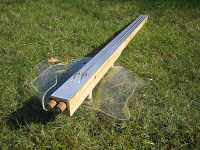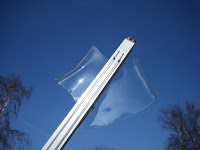Guitar
 With the addition of a body to the T-beam bass, it begins to resemble an instrument.
With the addition of a body to the T-beam bass, it begins to resemble an instrument.
The body is a 3 mm (around 1/8") acrylic (or plexiglass) shield, cut with a saw and an angle grinder, polished, and bent in shape with a hot air gun. As with almost everything else on the bass, it is not intended as the final version. For this, I will use thicker (probably 5 mm) acrylic sheet and have the leg rest further to the back.
The acrylic shield is slightly bowl-shaped so it follows the contours of my body. It's a fairly deep bowl shape ;-) It has a leg rest bent into the lower part and an arm rest created by folding back a wing on the upper part. It quite looks like the body of an Ovation Breadwinner, though that was not the intention originally. It's very comfortable, and I expect it to be even more so when I've moved back the leg rest.
 The four mounting supports that connect the shield to the stick will have to be replaced with a central support mounted on one of the two places where the stick has least vibration. A so-called node. I located the node by suspending the stick on two springy foam blocks, pouring salt on the stick and tapping it with a knife handle. As predicted in the marimba literature, the salt would gather to show the location of the node. Luckily, the node is somewhere in between the mounting supports, which makes construction easy. BTW; marimba and vibraphone builders do a lot of interesting research into the acoustics and vibration of wood; something that the guitar builders might draw upon in their work.
The four mounting supports that connect the shield to the stick will have to be replaced with a central support mounted on one of the two places where the stick has least vibration. A so-called node. I located the node by suspending the stick on two springy foam blocks, pouring salt on the stick and tapping it with a knife handle. As predicted in the marimba literature, the salt would gather to show the location of the node. Luckily, the node is somewhere in between the mounting supports, which makes construction easy. BTW; marimba and vibraphone builders do a lot of interesting research into the acoustics and vibration of wood; something that the guitar builders might draw upon in their work.
 The reason for having the shield mounts on the node is to preserve vibration in the stick and not have it travel through the body and into the all-absorbing torso of the player. The node does not vibrate - or at least it vibrates less than other areas of the stick, meaning that less vibrations will be transferred from this point to the shield than from any other areas. I expect it to have a pronounced effect on sustain, and perhaps also on tone.
The reason for having the shield mounts on the node is to preserve vibration in the stick and not have it travel through the body and into the all-absorbing torso of the player. The node does not vibrate - or at least it vibrates less than other areas of the stick, meaning that less vibrations will be transferred from this point to the shield than from any other areas. I expect it to have a pronounced effect on sustain, and perhaps also on tone.
Some sort of leaf spring suspension mount might give even better isolation between the shield and the stick, but that will have to wait for a later version.
- Truly Headless
After postponing it a number of times, I cut off the strat headstock of my very fine Warmoth neck. That took a bit of self persuation, but I needed it headless. A brass angle bracket is holding the strings. I also made a new acrylic body. This time, I...
- Exposed Cabling In Copper Tubes
The black SG that I used for experiments with coarse and fine tuners has been modified further. I wanted to be able to phase switch the pickups. Plus, I'd had this idea of having the cables run in copper tubes to shield them from noise. The copper...
- To-do List
Nothing much has happened on my T-beam-bass lately. I've replaced the jack connector since the old one didn't work and clamped the connecting cable going from the jack more securely to the sliding bracket. Plus, I've borrowed a friend's...
- New Tuners
I've always wanted to try out my a particular form of tuners for headless guitars and basses. They work by having a scew pulling a brass block in which the ball end of the string is mounted. The main inspiration was Jeff Turpin's tuners; drawings...
- Setting My Sights A Little Lower
It can't have escaped anyone's attention that I haven't yet built the T-beam guitar. Even though I've talked a lot about it, nothing tangible has emerged. I've bought the components and there's nothing much missing. It's just...
Guitar
A body that preserves vibration
The body is a 3 mm (around 1/8") acrylic (or plexiglass) shield, cut with a saw and an angle grinder, polished, and bent in shape with a hot air gun. As with almost everything else on the bass, it is not intended as the final version. For this, I will use thicker (probably 5 mm) acrylic sheet and have the leg rest further to the back.
The acrylic shield is slightly bowl-shaped so it follows the contours of my body. It's a fairly deep bowl shape ;-) It has a leg rest bent into the lower part and an arm rest created by folding back a wing on the upper part. It quite looks like the body of an Ovation Breadwinner, though that was not the intention originally. It's very comfortable, and I expect it to be even more so when I've moved back the leg rest.
Some sort of leaf spring suspension mount might give even better isolation between the shield and the stick, but that will have to wait for a later version.
- Truly Headless
After postponing it a number of times, I cut off the strat headstock of my very fine Warmoth neck. That took a bit of self persuation, but I needed it headless. A brass angle bracket is holding the strings. I also made a new acrylic body. This time, I...
- Exposed Cabling In Copper Tubes
The black SG that I used for experiments with coarse and fine tuners has been modified further. I wanted to be able to phase switch the pickups. Plus, I'd had this idea of having the cables run in copper tubes to shield them from noise. The copper...
- To-do List
Nothing much has happened on my T-beam-bass lately. I've replaced the jack connector since the old one didn't work and clamped the connecting cable going from the jack more securely to the sliding bracket. Plus, I've borrowed a friend's...
- New Tuners
I've always wanted to try out my a particular form of tuners for headless guitars and basses. They work by having a scew pulling a brass block in which the ball end of the string is mounted. The main inspiration was Jeff Turpin's tuners; drawings...
- Setting My Sights A Little Lower
It can't have escaped anyone's attention that I haven't yet built the T-beam guitar. Even though I've talked a lot about it, nothing tangible has emerged. I've bought the components and there's nothing much missing. It's just...
